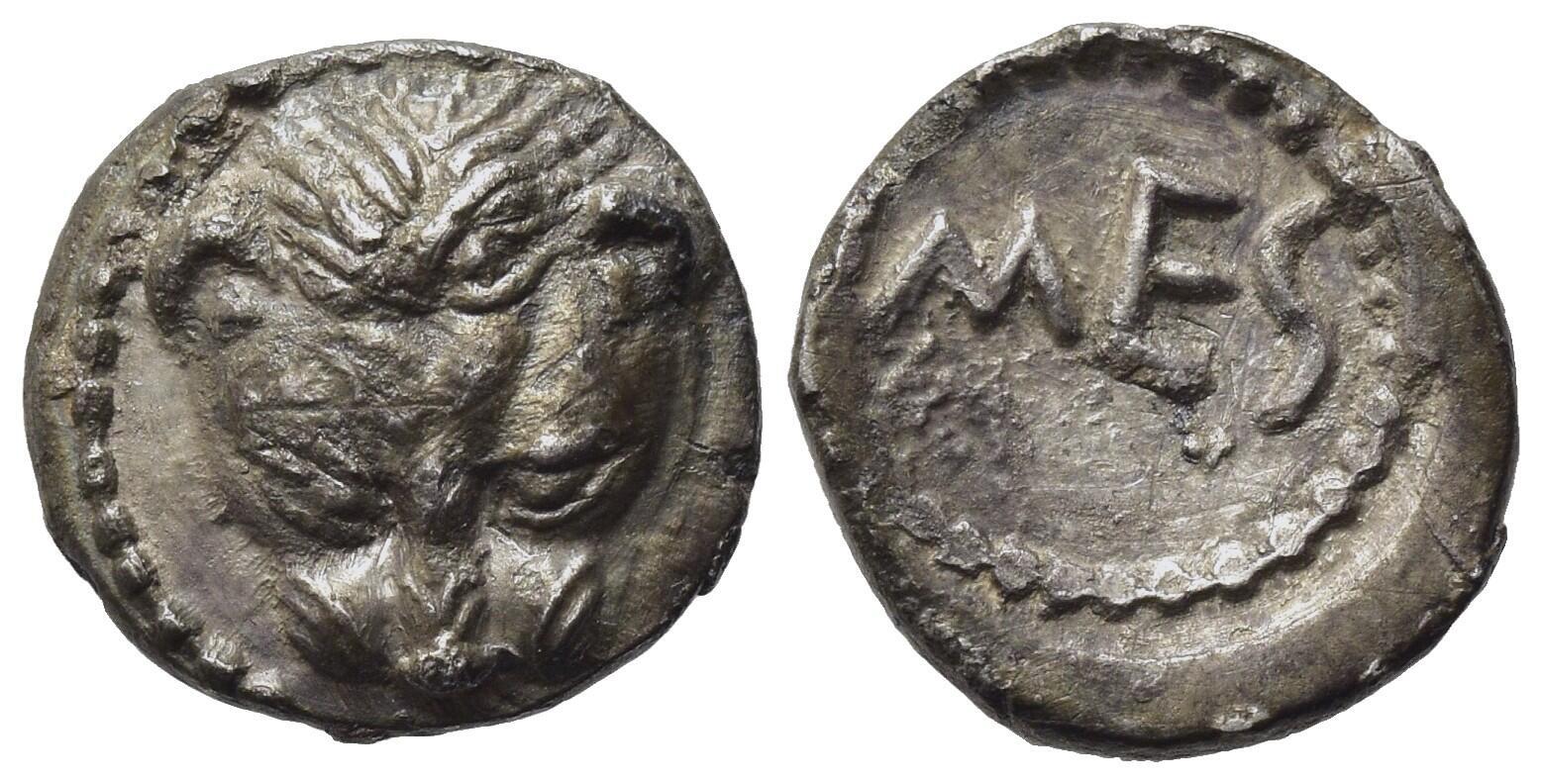AC 64a - Messana, silver, litrae (488-481 BCE)
From SILVER
488 BCE - 481 BCE Silver 118 kg
Description
| ObverseInscription or printing placed on the obverse.: | Facing head of lion within dotted circle. |
| ReverseInscription or printing placed on the reverse.: | MES (Greek).MES within dotted circle |
Mint and issuing power
| MintIdentifies the place of manufacture or issue of a numismatic object.: | Messana | Ancient regionAncient region.: | Sicily | Modern countryModern country: Italy | AuthorityIdentifies the issuing power. The authority can be "pretended" when the name or the portrait of X is on the coin but he/she was not the issuing power. It can also be "uncertain" when there is no mention of X on the coin but he/she was the issuing power according to the historical sources: | Anaxilas, tyrant of Rhegium |
Chronology
| FromIdentifies the initial date in a range assigned in a numismatic context. | 488 BCE | toIdentifies the final date in a range assigned in a numismatic context.. | 481 BCE | PeriodTime period of the numismatic object.: Archaic until 480 BC |
Physical description
| MetalThe physical material (usually metal) from which an object is made.: | Silver |
Median weightMedian of the weights of numismatic objects (in grams). in grams | 0.90 | DenominationTerm indicating the value of a numismatic object. Examples: tetradrachm, chalkous, denarius.: | litra |
StandardStandard.: |
Image

AC 64a - Zancle, litra, 488-481 BC.jpg [1]
References
| Die study referencePublication of the study: | Caccamo Caltabiano 19931Caccamo Caltabiano 1993, n° 14-21. | ||
| Coin series referenceReference to coin series study: | Sear I2Sear I, n° 726, RQEMAC3RQEMAC, n° 64a, HGC 24HGC 2, 811 | ||
Obverse dies distribution
no distribution is available
Reverse dies distribution
no distribution is available
Quantification
| Number of obversesNumber of obverse dies. ᵖ (o) | 5 | Number of singletons (o1)The number of singleton coins. ᵖ | |
| Number of reverse diesNumber of reverse dies. (r) | 7 | Number of coinsNumber of coins. (n) | 14 |
| Coins per obverse dieNumber of coins per obverse die. (n/o) | 2.8 | Coins per reverse dieNumber of coins per reverse die. (n/r) | 2 |
| Reverse per obverse ratioRatio of obverse dies divided by reverse dies. (r/o) | 1.4 | Percentage of singletons (o1)number of coins (n) divided by the number of singletons (o1) ᵖ | % |
| Original number of dies (O) (Carter 1983 formula)The estimation of the number of coins according to Carter 1983 ᵖ | 6.57 | Coins struck if 20,000 as average productivity per dieCoins made if the average productivity for obverses (according to Carter) is 20,000. ᵖ | 131,400 |
| Original number of dies (O) (Esty 2011 formula)The estimation of the number of coins according to the singleton formula in Esty 2011 ᵖ (O) | 7.78 | Survival rate if 20,000 as average productivity per dieSurvival rate if average productivity is 20,000. ᵖ | 0.00011 |
| Coverage (o = % of O) (Esty 1984 formula)Esty 1984 - coverage (% of O) ᵖ (o = % of O) | % | Die productivity if survival rate 1/2,000Average productivity if survival rate is 1/2,000. ᵖ | 4,261.8 |
| Weight of silver (in kg) if 20,000 coins per die (O = Carter formula)Carter 1983 * Median weight * 20000 (*10 if gold or electrum) ᵖ | 118 kg <br /> 118 kg | Die productivity if survival rate 1/5,000Average productivity if survival rate is 1/5,000. ᵖ | 10,654.49 |
Remarks